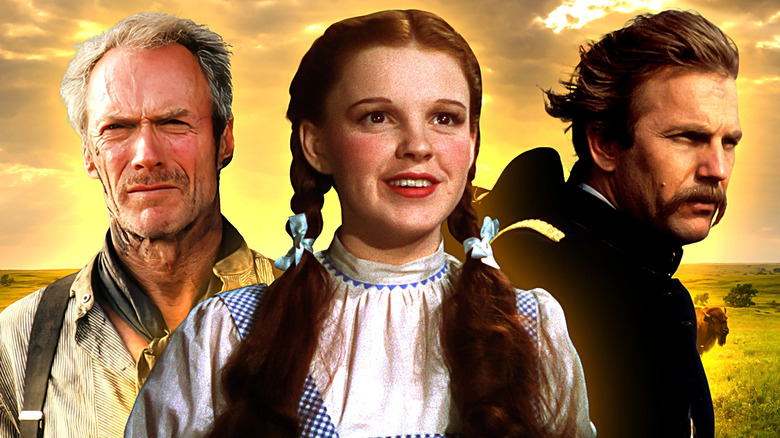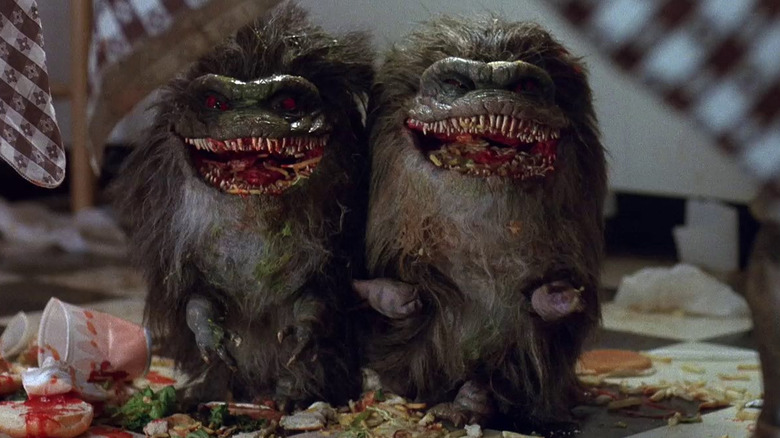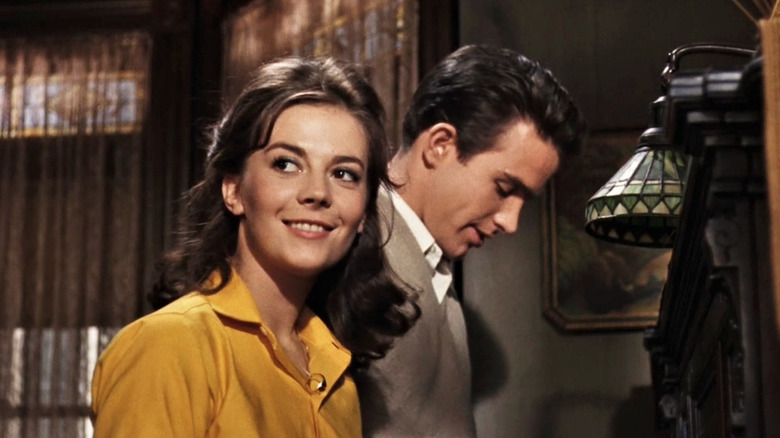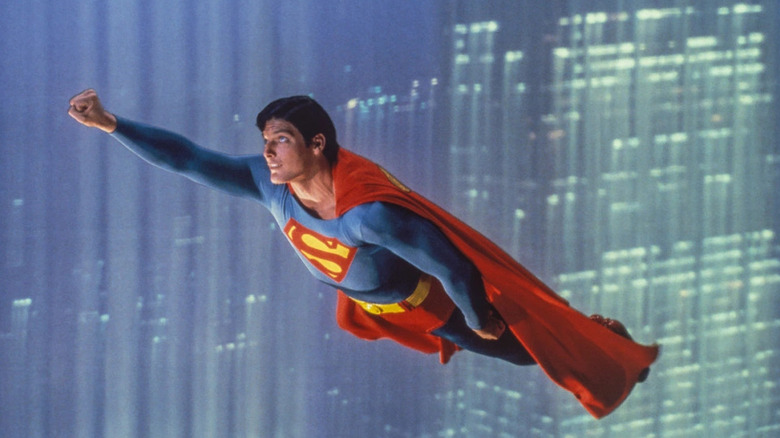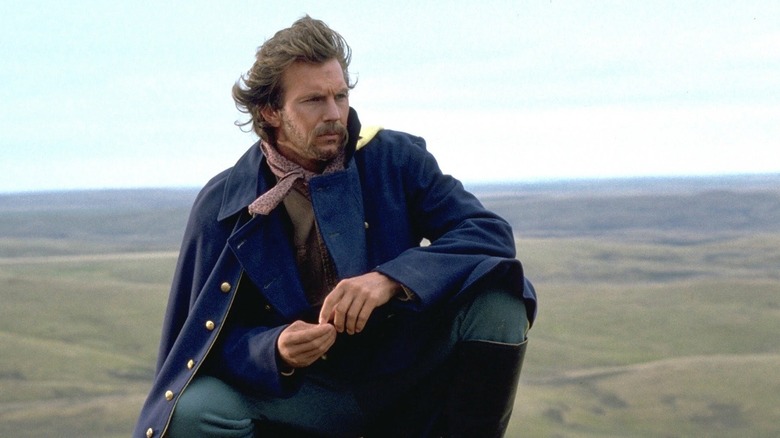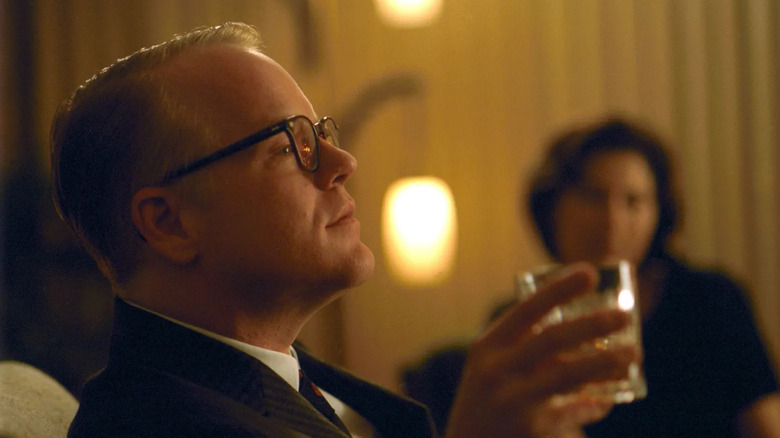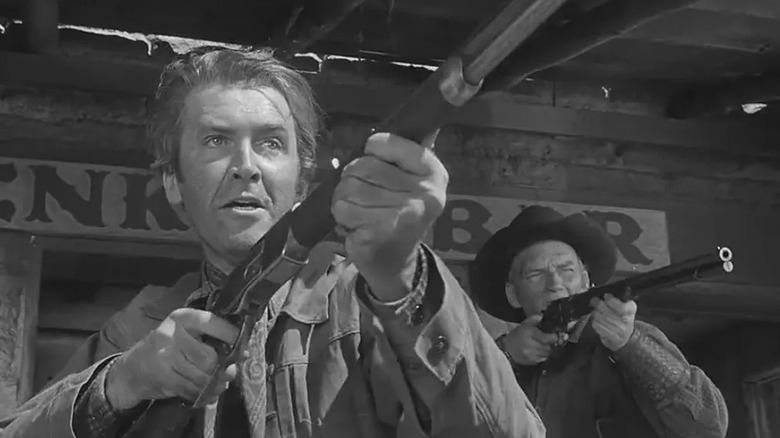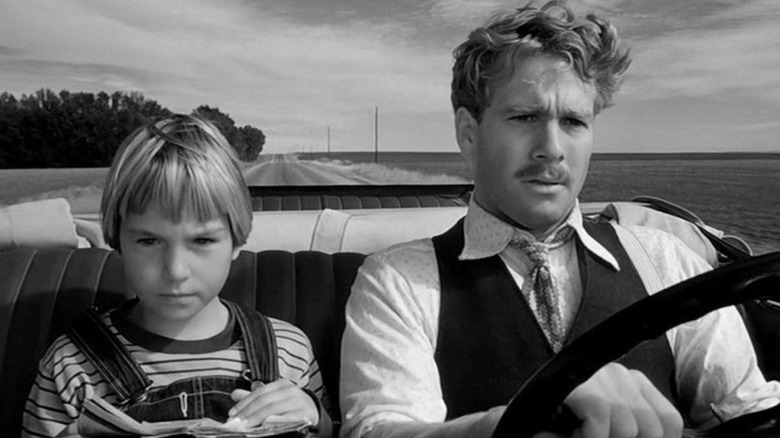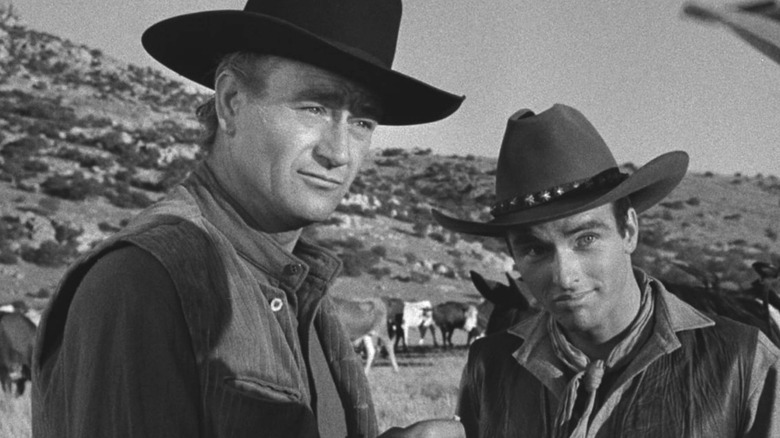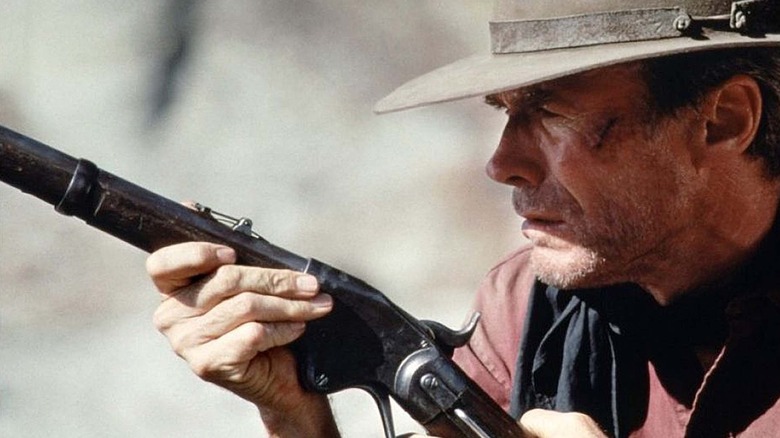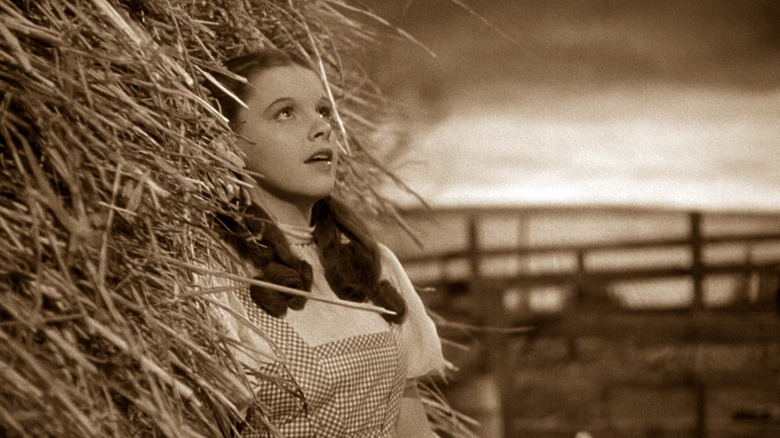10 Best Movies Set In Kansas, Ranked
"Toto, I've a feeling we're not in Kansas anymore," Dorothy famously stated in a movie quote considered the fourth greatest ever by the American Film Institute. No, Dorothy, you're not — you're in Hollywood! With a population just shy of three million, the entire state of Kansas has less residents than New York City and Los Angeles, while it's just a hair above Chicago. Yet when it comes to the movies, "The Wheat State" punches far above its weight, with cinematic representation including Academy Award winners, blockbusters, and even films that have joined the hallowed ranks of the National Film Registry. What gives?
Perhaps it's because filmmakers consider the 34th state the perfect great plains state, with its waving wheat fields and endless horizons. More than anything, maybe it's the welcoming Kansas culture of "midwest nice" that has never met a stranger. Whatever the reason, "The Sunflower State" has proven to be fertile cinematic soil for the silver screen since the film business began more than a century ago. So we decided to rank the 10 best movies set in Kansas.
Frankly, it was hard to narrow our list down to just 10 films, and it was even harder to rank them. Full disclosure: Not everyone of these movies is an "award winner." Like the state itself, this is a surprisingly diverse and varied list, with many entities that have little in common with each other besides the fact they take place in Kansas.
Without further ado, here are the 10 best movies set in Kansas!
Critters
Fresh off smash hit success of Joe Dante's 1984 "Gremlins" (set up north in Kingston Falls, Pennsylvania), came 1986's similarly themed "Critters." Many have debated whether this strikingly similar horror-comedy hybrid is a "knock off" of "Gremlins." Sure, it's suspiciously also about a menagerie of menacing and mercurial creatures that escape to mercilessly destroy a charmingly quaint community for their own amusement. But what's non-debatable is "Critters" spawned a franchise that has lasted four decades and includes five films and even one TV show, which is more than we can say for its, ahem, "inspiration" in "Gremlins."
Directed by Stephen Herek, "Critters" follows extraterrestrial creatures who look like hedgehogs from hell known as "Krites," who are totally not Gremlins. While being transported, a few Krites bust out of an alien asteroid prison, hijack a ship, and crash land on a small Kansas farm owned by the Brown family, who must fend off the fiends, while the town deals with the shape-shifting space bounty hunters who are pursuing the Krites.
This is elevated B-stuff, which somehow managed to recruit the acting talents of Dee Wallace, just a few years after starring in "E.T. The Extra-Terrestrial," and the always welcome M. Emmet Walsh. "Critters" is definitely an acquired taste, because, despite its charms, it's a wee bit derivative, so much so it has divided moviegoers. But for those who have a taste for its zaniness, it's definitely one of the best movies set in Kansas.
Splendor In The Grass
"Splendor In The Grass" is basically the great-grandfather for every "pretty high schoolers with problems" show that followed. You can see its tropes hidden in its descendants like "Dawson's Creek," "Smallville," and "Friday Night Lights," (we could go on). Set in 1928, "Splendor In The Grass" stars Warren Beatty in his film debut as Bud, a smalltown Kansas teenager whose future is bright with admission to Yale University on the horizon. Alas, he yearns for a more, ahem, "physically intimate relationship" with his high school sweetheart, Deanie (Natalie Wood). The call of the loins is impeded by their parents, each for different reasons: Deanie's mom doesn't want her to develop a reputation, while Bud's dad doesn't want marriage and a baby to stymie his Ivy league ambitions.
This tale of forbidden teenage trysts may seem trite today, but it was downright scandalous back in 1961. Bosley Crowther, movie critic for "The New York Times," said "Splendor In The Grass" was a "frank and ferocious social drama that makes the eyes pop and the modest cheek burn." While contemporary audiences are unlikely to pop their eyes or burn their cheeks, the film's Romeo & Juliet-esque exploration of forbidden love and oppressive expectations will remain timeless, as long as there are horny, hormone-motivated teenagers in the world. Kansas probably doesn't appreciate being the archetype for sexual autocracy, but the state can admire "Splendor" earning a Best Actress nom for Natalie Wood and a win for William Inge's screenplay.
Superman: The Movie
"You'll believe a man can fly!" is one of the great movie taglines. While some grouches may say that the tagline and movie it promoted are dated, we find it endearing, charming, and timeless, which are equally accurate descriptions for "Superman: The Movie." The story is... well, you know the story. The last son of the doomed planet Krypton crash lands in the make-believe town of Smallville, Kansas, and grows up to become the defender of truth, justice, and the American way. What may seem cliche today was still fresh in 1978, as "Superman: The Movie" not only launched the superhero genre, it remains one of the best superhero movies.
The promise of seeing the Big Blue Boy Scout get a big budget, big stars (Marlon Brando and Gene Hackman), and big blockbuster storytelling helped the movie fly up, up and away with $300 million worldwide, second only to "Grease," (yes, a period musical topped a superhero movie at the box office; what a time to be alive). We contend it was Christopher Reeve as the titular Man of Steel who made this movie not just a superhero classic, but a classic, period. Put simply, Reeve delivers a superhero performance that is practically flawless. Despite hailing from the Big Apple, Reeve perfectly personified Clark Kent's "aw, shucks" Kansas roots, which was the ideal antidote to a cinematic culture awash in 1970s cynicism. Throw in John Williams' rousing score, and "Superman: The Movie" continues to make believers out of us.
Dances With Wolves
While some critics may have soured somewhat on "Dances With Wolves" in the past few decades, there's no denying its accolades. Besides making $424 million worldwide (behind only "Pretty Woman," "Home Alone," and "Ghost") it cleaned up at the Academy Awards, earning 12 noms, and seven wins, including Best Picture and Best Director for star Kevin Costner. Ironically, this hurt its reputation, as many film fans feel passionately that Costner beat Martin Scorsese's far-more deserving "Goodfellas." But hey, a wins a win no matter how you get it (just ask the Kansas City Chiefs).
Costner stars as Lt. John Dunbar, who survives a would-be suicide attempt that winds up winning a major battle for the Union. Following his brush with death, Dunbar requests he be sent to the frontier before it disappears. So naturally, they send him to Kansas. Dunbar arrives at Fort Hays, where his commanding officer stations him in the furthest outpost. There Dunbar starts a relationship with a band of Lakota Sioux, eventually being adopted into the tribe and given a name, Dance with Wolves.
Sure, we could do without its "white savior meets noble savages" stereotype, but movies don't come much prettier than "Dances With Wolves," including its stunning, scenic shots of Kansas. Despite not being as good as its gilded glory would suggest, "Dances With Wolves" is still a wonderful watch. It remains Kevin Costner's crowning career achievement (before he squandered it as he habitually does), and one of his best movies.
In Cold Blood and Capote
"In Cold Blood" and "Capote" belong on any list of great movies set Kansas. Since they tell basically the same story from two different points of view, we're pairing them together. "In Cold Blood" is the 1967 neo-noir based on Truman Capote's 1965 true-crime novel of the same name, itself based on the real-life 1959 murders of the Clutter family in the small farming community of Holcomb, Kansas. It tells the sordid tale of ex-cons Perry Smith and Dick Hickcock, whose plan to rob the wealthy Clutter family's safe backfires when they find the safe empty, and murder the family in a rage worthy of the title.
You can see this film's chilling influence on crime movies to follow, most notably The Coen Brother's "Fargo." However, both the book and the movie bear the unmistakable imprint of author Truman Capote.
Ironically, it's the movie named "Capote" (seen above) that is not from his perspective, but rather about him. The late Phillip Seymour Hoffman gives his only Oscar-winning performance (just one of his many great performances) as the Southern-born, Manhattan-based author who departs the cozy confines of New York high society to write about the 1959 murders. Along the way, he forms a relationship with Perry Smith (Clifton Collins Jr.), while fracturing relationships with others, including long-time friend and confidant Harper Lee (Catherine Keener). Which is better? We can't say. All we can say is that each is essential viewing when it comes to movies set in Kansas.
Winchester '73
If you only know James "Jimmy" Stewart from Christmastime viewings of "It's A Wonderful Life," him playing a stone-cold cowboy may sound like a "SNL" sketch. Well, you need to do yourself a favor and watch "Winchester '73." While Stewart is best remembered for his three Frank Capra collaborations, his four Alfred Hitchcock films, or his three John Ford features, his most prolific pairing was with Anthony Mann, making eight movies together, five of them westerns. Each one is worth a watch for any Stewart-loving cinephile, but none ranks higher than "Winchester '73," their first (and best) collaboration – and one of Stewart's many movies to achieve a perfect Rotten Tomatoes score!
In the 1950 film, Stewart plays Lin McAdam, a cowboy with a score to settle with an outlaw named Dutch Brown (Millard Mitchell). McAdam's trek takes him to Dodge City, Kansas, where he wins a sharp-shooting contest, and with it the grand prize: the titular rifle. Well, Brown makes the mistake of his life, stealing the rifle – and inspiring McAdam's obsessive cross-state journey to get it back. If this sounds more like a film noir than a western, you're not wrong. Mann cut his teeth in the 1940s making urban crime pics and brought that bullet-ridden realism to the old west, reinventing a genre that even in 1950 was growing stale. "Winchester '73" was a hit, and its reputation has only grown, as it clearly inspired the gritty, bloody westerns of the '60s and '70s that followed.
Paper Moon
"Take your daughter to work day" takes on a literal meaning in Hollywood, particularly if you're the O'Neal family. Ryan O'Neal shares the screen with his daughter Tatum O'Neal, playing con-artist Moses Pray, who finds himself saddled with Addie Loggins, who may or may not be his daughter. Pray agrees to take the kid across Kansas to relatives in Missouri, but when his plan to get her money backfires, he gets a better idea. See, the appropriately named Pray pretends to sell personalized Bibles to recently widowed women, claiming their husbands purchased the expensive books before passing. It's a small-time operation aided by the adorable and innocent Addie, and the two form a partnership swindling widows across Kansas farm country.
Ryan O'Neal gives a career-best performance in "Paper Moon," though it's his daughter who steals the show. Tatum O'Neal won Best Supporting Actress at the 1974 Academy Awards for her performance, becoming the youngest actor to win a competitive category, a record she holds to this day. Noticeably snubbed for any awards was cineaste-turned-director Peter Bogdanovich, who made what is arguably the best movie of his career. Famous among film buffs as the refined, ascot-wearing champion of classic filmmakers like Orson Welles and Alfred Hitchcock, Bogdanovich himself was once a major New Hollywood filmmaker. However, "Paper Moon" stands out from its sex, violence, and profanity drenched 1970s contemporaries. This charming 1973 films could hav ecome out during its 1930s setting, and is definitely the road to movie heaven.
Red River
Kansas is frequently the setting ("In Cold Blood," "Paper Moon") or the starting point ("Superman: The Movie," "The Wizard of Oz") for a movie. "Red River" is one of few great movies where Kansas is the destination.
Starring John Wayne and Montgomery Clift, Howard Hawks' 1948 western "Red River" tells a fictionalized version of the first cattle drive along the Chisolm Trail from Texas to Kansas. Wayne plays Tom Dunson, a cantankerous Texas cattle rancher whose success is matched only by his stubbornness. Needing money following the Civil War, Dunson leads a cattle drive out of state, where he hopes to snag a better price than he can locally. He's joined on the journey by his long-serving hand Groot (Walter Brennan) and his adopted son Matt (Clift). Tempers flare and eventually explode during the exhausting journey, as the headstrong Dunson and his equally willful son begin to butt heads, and worse.
Avowed Hawks aficionados will admire the film's meditation on masculinity, particularly the thin line that separates loving fraternity from combative confrontation. Hawks couldn't ask for a better cast, as Wayne's old school, larger-than-life starpower plays well against Clift's ahead-of-its-time method acting. Wayne does what he does best (play John Wayne), Clift gives a riveting performance that foreshadows the naturalistic style that would soon dominate the scene, and Brennan reminds us why he was among the greatest character actors ever. Kansas was the destination, but the journey makes "Red River" one of the best westerns ever.
Unforgiven
At the film's climax, the unforgivable, old west gunslinger Will Munny (Clint Eastwood) tells his latest victim that he's killed "just about everything that walks or crawled at one time or another." Up to that point, Munny had been telling everyone that would listen he wasn't like that anymore. Now he has reverted back to his old ways in a ballet of bullets and blood, forcing the viewer to ponder if truly vicious and violent people can ever truly change. The timeless power of "Unforgiven" is that it never gives us an easy answer.
We first meet Munny buried face-deep in pig slop, a widower who abandoned his wicked ways to become a failed farmer in Hodgeman County, Kansas. But with his farm falling apart and his motherless children's futures in jeopardy, Munny abandons the plow for the pistol to answer a $1,000 bounty in Big Whiskey, Wyoming on cowboys who mutilated a prostitute. Kansas represents peace and tranquility in "Unforgiven," but a man like Munny wasn't made for such things. His descent down into the darkness and back to the merciless frontier from whence he came is masterful storytelling.
"Unforgiven" was nominated for nine Academy Awards and won four in 1993. Pointing to its trophy cabinet doesn't do the movie about injustice any justice. More than 30 years since its release, with numerous Eastwood pictures following, many fans believe "Unforgiven" remains the best Clint Eastwood movie, high praise for one of the greatest of all Hollywood careers.
The Wizard of Oz
While there were many worthy contenders, perhaps no other movie could truly be called the "best movie set in Kansas" besides "The Wizard of Oz." Released in 1939, considered one of the greatest years in movie history, "The Wizard of Oz" is perhaps the best among the rest. It has stood the test of time because in many ways it is more than a movie. It is the very embodiment of cinematic storytelling; a timeless totem that perfectly encapsulates the very meaning of the medium of film. The movie's power is its pure imagination, pure and simple.
One of its most enduring and indelible legacies is its depiction of Kansas during the Dust Bowl, one that continues to shape the world's view of "The Sunflower State." Some even argue its representation of Kansas holds the state back from how it wants to be seen, and what it believes it can be. We must admit, they may have a point. In stark contrast to the bright and breathtaking Technicolor dreamworld of Oz, Kansas is portrayed as a bleak, black-and-white prison that Dorothy yearns to escape and go "Somewhere Over The Rainbow." Yet Kansas critics of "The Wizard of Oz" must remember the movie is a metaphor for Dorothy's coming-of-age awareness about what really matters. Following her magical adventure in Oz, she rhythmically taps her ruby-toed slippers together and hopefully pleads five simple words: "There's no place like home." That home is Kansas.
